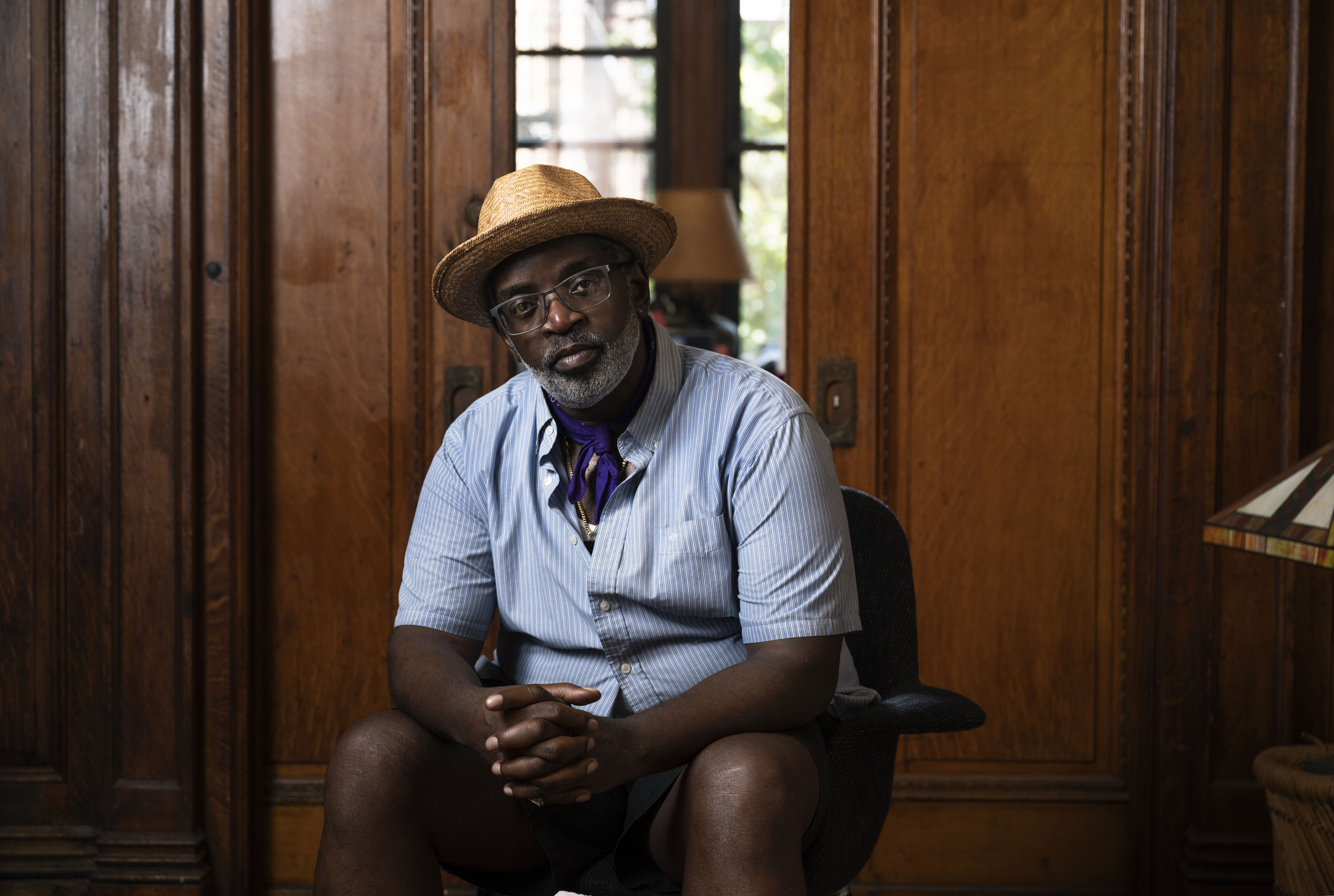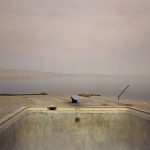Photographers on Photographers: Alex Henderson in Conversation with Idris Talib Solomon
On a search to find more Black photographers and artists, I discovered The Black Shutter Podcast. From Jamel Shabazz to Dee Dwyer, I listened to each artist’s story as they were relatable and inspiring. As a developing artist, I felt that I struck true gold with my newfound resource. As I listened, I realized that the stories of the visiting artists were just as motivating as the host conducting the interviews. This is where I learned more about the work of Idris Talib Solomon.
Idris Talib Solomon focuses on stories that are overlooked and lack proper representation within the Black community.
He photographs dancers and gymnasts in Harlem, funeral homes in East New York, muralists in Bushwick, Black cowboys in Houston, athletes and extreme racers in Fiji, 80mph racing drones in France, unit stills for television and movies. He also regularly photographs his wife and son.
He is the Creative Director and host of The Black Shutter Podcast. Tune in.
Follow Idris Talib Solomon on Instagram: @idrissolomon
Alex Henderson: How did you get started in photography?
Idris Solomon: I wish I could say that I have a specific memory or life event that sparked my interest in photography. But I don’t. I’ve been an artists for as long as I can remember. Art has always been a form of expression — a translation of my imagination into something visual. Photography was just another way for me to communicate my thoughts. My first real interaction with photography was at Binghamton University. I took a Black & White photography class. All film. Red light darkroom status. Digital didn’t exist at the time. I majored in Art Studio (a major I created for myself with University approval) which meant that I can take any art classes I want. I studied graphic design, motion design and advertising. It was dope but there was no structure. In hindsight, maybe that was the best approach. It allowed me to craft my education and career in a way that resonated with my personality. And I continue to navigate my professional life in very much the same way.
AH: Do you prefer pictures over video?
IS: After years of developing my eye of photography, I realized that I have a love for video as well. I began studying composition and lighting in movies. I loved the storytelling aspect in both documentary and narrative films. I wanted my photos to look cinematic. So I made a mini documentary about a Black LaCrosse director based in Brooklyn. I discovered the best way to make images look cinematic was to practice filming movie images. The combination of graphic design, photography and videography helps me to see storytelling with a unique perspective. I realized that I love video but not necessarily operating the video camera. I am enjoying directing stories and working with a team of talented people on a collective goal.
AH: Do you have any inspirations for creative direction?
IS: I love the beginning stages of a new project. There is always a time that is dedicated to research and development. And for me that means pouring my favorite drink and nerding out for hours on Behance, Pinterest, and all the design rabbit holes they lead to.
I wish I spent more time in a research and development zone because it’s always great to see what is trending. Who is doing something new? Experimental? Is my work evolving? Stagnating? Do I enjoy what I am creating? While it’s easy to compare my work to others, I’m learning to look at the great work of others with admiration and fascination. It keeps me humbled and motivated simultaneously.

© Dance Theatre of Harlem, 2016
AH: How do you find motivation for your artwork?
IS: Currently, my company Black Shutter Productions, keeps me motivated. Black Shutter began as a chat group with a handful of Black Photographers who met at the New York Times portfolio review. It then morphed into a community, then a podcast, and now a production company. Our mission is to tell stories in the Black community, created by Black artists. We are building on three pillars of education, inspiration, and compensation. Having a goal that is bigger than me keeps me motivated daily to keep doing this work.
AH: Do you feel that you fit into one style of photography/videography?
If so, do you ever venture outside of these styles?
IS: Creatively, I don’t know how to categorize my style. I don’t want to. But, I will say that I look for authenticity in every moment. If I’m photographing an event, I want my presence to be minimal. I’ve often been referred to as a ninja because I pop out of the shadows to make a photo and then disappear like smoke. That was the greatest compliment I could receive. For me, it means that people are being themselves and they aren’t distracted by me and my camera. I love making images in that kind of environment. I sometimes set up studio lights to photograph still objects around my home. It’s a way for me to practice lighting and experiment with self portraits. This exercise has been helpful for jobs that require me to photograph outside of my perceived skill set. It’s a hidden skill that I pull out of my back pocket and it has saved the day a few times.
AH: How did you get started working with HBO?
IS: My career has been a zig-zag of opportunities and decisions. At a certain point, after being fired from every job that was not creative, I realized that being an artist is in my blood. It’s something that I cant deny or neglect. My appreciation and experience with several forms of art provided me with a unique skill set. This skill set landed me in an art director role at HBO where I created assets for shows like Lovecraft Country, Game of Thrones, High Maintenance and Euphoria. As an art director, it’s important to understand how images, design, color, text and motion all work to communicate a consistent message or feeling.
AH: Congratulations on hosting Photoville 2022! Can you elaborate on this experience?
IS: What has been consistent for me in my career is the need to portray the Black community in a more positive light. This need is not inspired by any jobs that I do. It is an internal drive. When I am in a position to make decisions on how to art direct a campaign or photograph a story, I am hyper aware of how Black people are presented. This year, I had the honor of opening the annual Photoville festival at Brooklyn Bridge Park. It was a great opportunity to showcase the work we’ve been doing with the Black Shutter Podcast and introduce the work to a new audience. I shared a 15 minute video presentation compiled of soundbites and portfolios of different guests followed by a live podcast recording with 4 amazing photographers (Keith Major, Laylah Amatullh Barrayn, Jeffrey Henson Scales, Melissa Alexander). It was a great night and the audience was hypnotized by the conversation.
AH: Do you have any advice for inspiring and upcoming artists?
IS: I’m often invited to speak with young people about my career path and the one thing I find myself repeating is: always have a personal project. I am a huge proponent of personal projects. They give us the space to experiment, self direct, and return to the joy of being creative without a deadline or a client hanging over our shoulder. Every time I pursue a new personal project and share it publicly I get more opportunities. It’s important to remember that the goal is not necessarily to get work, but there is a something dope about sharing projects that are unfiltered by outside opinions and constraints.
AH: What is next for you?
IS: So far, my career has been pretty exciting. At one point, I questioned if I was good enough to become a professional photographer. And then one day I woke up in Ghana or France or Fiji — all because of my camera. That’s so fucking crazy to me. But I am grateful for these experiences. I feel like I’ve made tough decisions, took some risks, conjured up courage to face my demons and that has paid off for me. In the future, I plan to continue taking risks, making even bolder decisions to help highlight and promote the talent in the Black creative community. And let’s see where that takes me.
Alex Henderson is a documentary and portrait photographer. She is a student at Arizona State University studying photography with a concentration in black & white and color film photography.
Henderson’s work involves filling comfortable and familiar spaces with different narratives and viewpoints to show various perspectives. Henderson is a mental health advocate whose work ties emotional awareness with visual documentation. Through engagement with her personal community, she works to assist in creating a better version of others through self work, self expression and visual representation. She captures moments shared within everyday life as documentation of growth and overcoming triumphs. Her current work is rooted in documenting her interactions and time spent with family and friends.
Posts on Lenscratch may not be reproduced without the permission of the Lenscratch staff and the photographer.
Recommended
-
Photographers on Photographers: Congyu Liu in Conversation with Vân-Nhi NguyễnDecember 8th, 2025
-
Photographers on Photographers: Mehrdad Mirzaie in Conversation with Liz CohenSeptember 4th, 2025
-
Photographers on Photographers: Elizabeth Hopkins in Conversation with Nicholas MuellnerAugust 21st, 2025
-
Photographers on Photographers: Cléo Sương Mai Richez in Conversation with Shala MillerAugust 20th, 2025
-
Photographers on Photographers: Emma Ressel in Conversation with Tanya MarcuseAugust 19th, 2025









































































